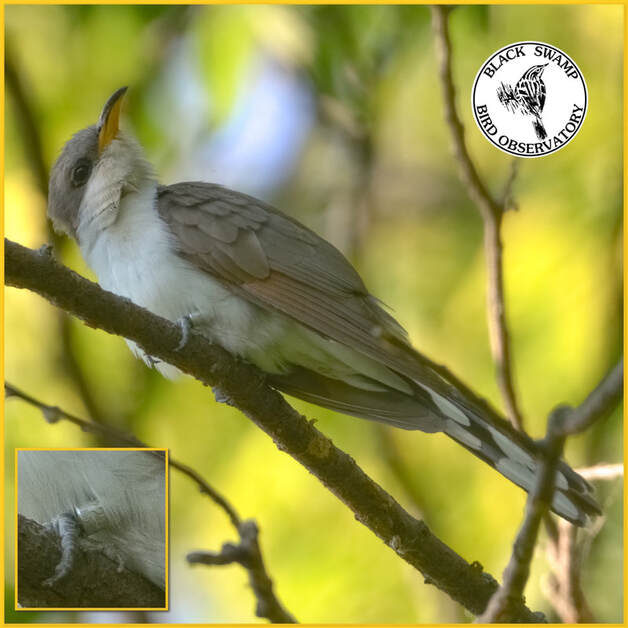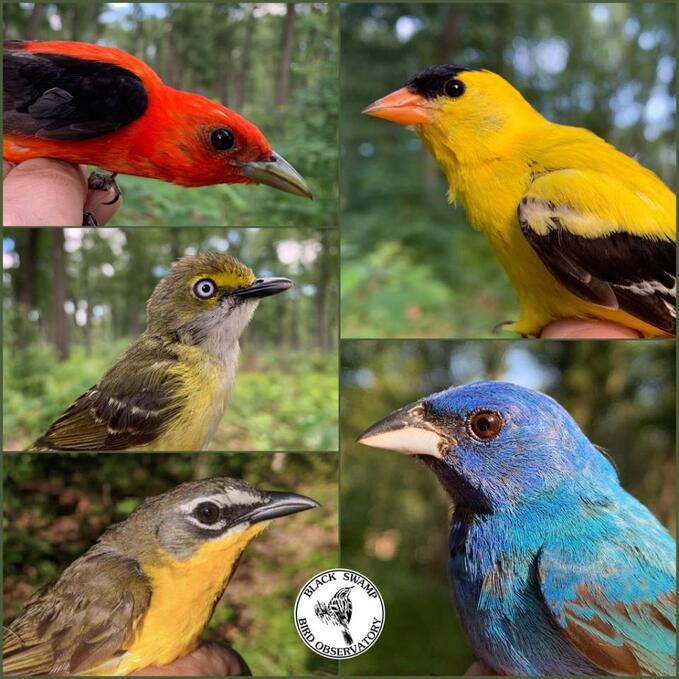Enjoying our blogs?Your support helps BSBO continue to develop and deliver educational content throughout the year.
|
|
After photographing this Yellow-billed Cuckoo (YBCU) for nearly half an hour, I was flabbergasted when I pulled up the photos on my computer and realized this bird was BANDED! In over 200 photos of this bird, the band showed for only a brief few seconds during the photoshoot owing to short legs and a cuckoo’s propensity for lounging low on a branch. While we’ll almost certainly never be able to read the band number well enough to determine which individual bird this is, the most likely explanation is that this is a locally-breeding, adult YBCU banded by BSBO in a previous year.
There are a few pieces of information that help us reach this conclusion. First, we know that BSBO did not band this bird in 2020, since we haven’t banded any YBCU this year, so if this bird was banded by us, it didn’t happen this year. Second, when we look closely at the band, we can see that the edges have been worn smooth and round, a phenomenon that only happens after (typically) years of wear on a band. This bird was definitely not banded any time recently. So we’re left with two explanations. Option a.) this bird was banded by BSBO in a previous year, or b.) this bird was banded by another bander/banding station in a previous year. In order to parse those options a bit further we need to consider recapture likelihood. “Foreign recapture,” a bird recaptured in a location away from its original banding site, is an occurrence that happens very infrequently in bird banding. A much more frequent occurrence is encountering a “return” bird, one that has been recaptured at the original banding location, but in a season other than that in which it was originally banded. Just considering this likelihood alone, the chance of this bird being a BSBO return is much higher than the chance this is a foreign recapture from another station. One final piece of natural history information helps us even further in our thought investigation. Many species of birds, including YBCU, show some site-fidelity to the breeding grounds, meaning they will return to the same general area year after year to breed, particularly if they have been successful in mating and raising young there. YBCU is a regular breeding bird in the Navarre Marsh and their “kowlp” calls echo through the June beach ridge forests each day once they make their return. While we may never be able to say for sure who this individual is or how old they are, one thing is for certain, the beach ridge habitat in Navarre Marsh is important breeding and stopover habitat for many tens of thousands of birds annually, plus one happy cuckoo. Don't forget to follow BSBO on Facebook where you can stay up-to-date with our daily point counts and join us every Wednesday (about a half hour after sunrise) for Morning Marsh Moments when we go live during our point counts and give a glimpse into BSBO's research station.
0 Comments
Typically at the end of the breeding season, our final MAPS update post would occur on the last day of field operations, and contain just that day's banding numbers. But we figured Hey! let's do a MAPS compilation this year like we would with migration. It was another great summer in the Oaks - even with the challenges of living in a socially distanced world - with a few surprise captures and a few questions to dig further into. Conditions were fair throughout the season and the summer heat never seemed to settle in quite as much as other years. Presented below are this summer's initial numbers (having gone through one stage of vetting so far) and impressions from the season.
Highlights: Red-headed Woodpecker, Scarlet Tanager, White-eyed Vireo, Yellow-breasted Chat, Mourning Dove, Blue-winged Warbler, and Chipping Sparrow. Although numbers are still initial and have yet to be compared to previous years, this summer felt a little slow and delayed. Numerous causes could have contributed to this feeling including spring weather, habitat management choices, vegetation density and maturity, and just plain 'ol wrong place wrong time; but the timing of peak activity felt to be off by about a week or so. Final analyzed numbers should shed more light on this. But while it may have felt "slow," one species that had an incredible summer was the Yellow-breasted Chat (YBCH). Northern Ohio sits at pretty much the northern extent YBCH's breeding range, resulting in relatively few encounters during migration and summer. Typically, we hope to catch 1 YBCH during banding operations in Oaks, but they appeared to have made quite the eruption this summer with numerous reports throughout the Oak Openings region. 8 being banded this summer exemplifies this surge as this is the highest number we've banded in a single season and represents 31% of the total YBCH that have been banded at the station since 1993 (26 in total from 1993-2020). *Typically we only provide the number of recaptures (a bird banded or encountered within season) in our updates, but we've decided to also include for this compilation the number of returns (birds banded in previous seasons). Among other things, returns can shed light on the number of adult birds returning to a habitat to breed, demonstrate the strength of site fidelity exhibited by a species, and help reveal the longevity of species from numerous years of encounters. For more info on BSBO's research at Oak Openings and the MAPS program, click here. To learn how you can help BSBO's research team and how to adopt a mist net, click here. Thank you to Metroparks Toledo for their support in our research of the birds of Oak Openings and their drive to implement wise and scientifically-based management practices for all wildlife. And THANK YOU to the volunteers that helped us succeed in this project!!! This year, more so than ever, their willingness to help during summer conditions, while also adhering to covid restrictions and best practices, made for safe operations for both people and birds. We would not have been able to do this without them. Again, Thank You! The MAPS program, developed by The Institute for Bird Populations is a continent-wide collaborative effort to assist the conservation of birds and their habitats through demographic and standardized monitoring. |
AuthorsRyan Jacob, Ashli Gorbet, Mark Shieldcastle ABOUT THE
|

